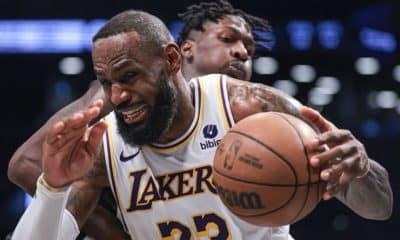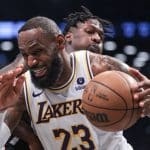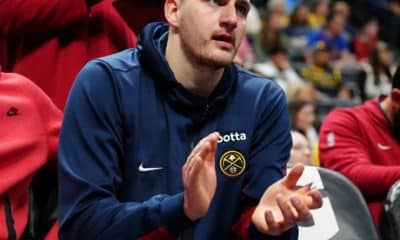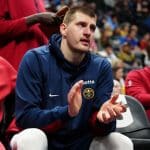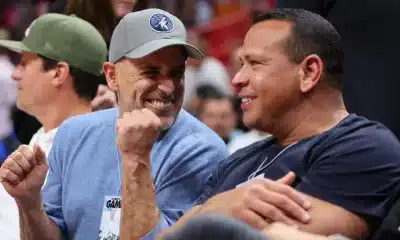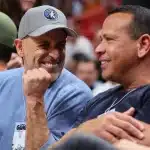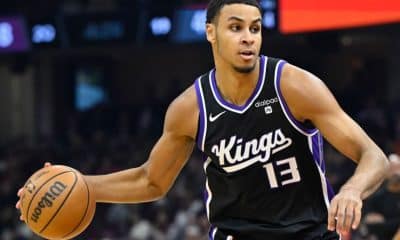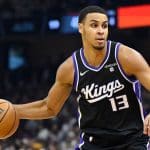NBA
The Phoenix Suns’ Path to Contention
How can the Phoenix Suns take the next step after inking Eric Bledsoe and the Morris twins?
The Phoenix Suns have been the NBA’s most newsworthy franchise over the last week, re-signing Eric Bledsoe to a five-year pact worth $70 million and inking brothers Markieff and Marcus Morris to four-year rookie extensions that kick in for the 2015-16 season. The Morris deals are solid; locking up a starting power forward (as Markieff projects to be) for only $8 million a year in a rising cap climate is solid value, while Marcus could also prove worth his contract even while acknowledging he might have been slightly overpaid to mollify Markieff.
Now that more of Phoenix’s core is locked in, what can we expect going forward? The backcourt of Goran Dragic and Bledsoe projects to be one of the NBA’s best. While Dragic is likely to decline after an age-27 season in which he far exceeded his performance to date, Bledsoe should counteract that with continued improvement. Adding Isaiah Thomas should allow Phoenix to keep its foot on the gas at all times with two scoring ballhandlers always in the game. The Suns appear poised to build on last year’s eighth-ranked offense.
But it is it is quite possible that it doesn’t happen that way due to the loss of Channing Frye. Markieff has flashed three-point range, but he has not shown anywhere near Frye’s shooting prowess in either accuracy or versatility. In fact, Frye was rather unique in that respect among big men. His superior size also gave him the ability to move to center defensively, making his jumper (and more importantly the threat of it) even more deadly. Indeed, Frye ranked as one of the league’s best non-stars by Real Plus-Minus (RPM) in 2013-14 due to his shooting gravity despite pedestrian box score statistics. Among power forwards, he ranked second in Offensive RPM behind Dirk Nowitzki. His 3.92 ORPM was about triple that of the highest rated center, Nikola Pekovic at 1.31. He was even about an average defender for a center by that metric. It is conceivable that Frye’s absence could cause Phoenix to take a major step back offensively and a slight one back defensively.
Nonetheless, the four-year, $32 million offer by the Orlando Magic to take Frye through his 35th birthday was likely an overpay by a team with no better use of its cap space. More importantly, the point here is to figure out how Phoenix can contend if everything goes according to plan with the current roster. If losing Frye kills the offense, Dragic regresses, the Morrises don’t improve or Bledsoe gets hurt again, they are in trouble regardless.
If the current players on the roster can fulfill the Suns’ high but not unreasonable hopes, this roster still tops out as a midpack team in the typically brutal West playoff bracket. In this scenario, the offense should be championship caliber, but it is hard to imagine the defense (13th last year with Frye and some smoke and mirrors by Hornacek) reaching the top 10 without a solid rim-protector and a wing stopper who does not sabotage the offense.
The current roster offers some eventual hope in that regard with center Alex Len, the fifth overall pick in the weak 2013 draft, but he has a long way to go. It might be too far to call it a lost rookie season for Len, but he did not really crack the rotation after a slow start due to surgery on both ankles. I wrote about Len last February, and we have little information to supplement that evaluation since then as he played little and missed summer league with a finger injury. Unfortunately, there is not much in his overall statistical resume at Maryland and in the pros to indicate he will be a quality starter.
Nevertheless, Len has physical potential defensively with his quick feet for his true center size and a 7’4 wingspan. In limited minutes he allowed a reasonable 48 percent shooting at the rim, so there is at least a slight indication he can evolve into a defensive stopper. But he will need to show a lot this year to convince the Suns that he is the long-term starter at center. The Suns may face criticism if he does not. Nerlens Noel went a pick later and may break out this year, although he brings his own positional and health issues.
Miles Plumlee will almost certainly start at center this year, but he projects as more of an energy big on a good team. He is not a particularly imposing deterrent at the rim due to being slightly undersized with average instincts, and he is already 26 years old. It does not seem likely he can develop into the type of stopper the Suns will need to contend.
Meanwhile, the wing stopper role is almost completely devoid of a realistic in-house solution. P.J. Tucker was re-signed over the summer to a three-year, $16.5 million deal, although the last year is only $1.5 million guaranteed. But he is not quite the caliber of player needed on either end, and he is already 29 years old. Tucker has little off-the-dribble game, is only a middling three-point shooter (especially above the break), and as a former power forward lacks the quick feet that define the best wing defenders despite his willingness to compete. Among the remaining options, Gerald Green has always been a bit too spacey despite solid physical tools, and T.J. Warren is a rookie who didn’t have much of a reputation for defense in college.
If Len doesn’t develop into a defensive stopper, what paths are available to the Suns to acquire the two key players needed? The crown jewel in Ryan McDonough’s war chest is the Lakers’ top-five protected 2015 draft pick from the Steve Nash trade, which should fall in the back half of the lottery. L.A. is unlikely to make the playoffs but should be good enough to avoid the top five. While drafting for need is always risky, shot-blocking centers like Kentucky’s Willie Cauley-Stein or Texas’ Myles Turner could be available in that range, though they will take time to develop. Another option would be trading that pick and perhaps other assets for an immediate starting center solution.
Warren, while he is not the greatest fit with this roster that already features plenty of scoring punch, could flash enough in his rookie year to be part of a trade package. Phoenix also will have its own draft picks at its disposal, plus a first-rounder* from Minnesota from the Wesley Johnson salary dump.
The Suns’ other option for improving the defense is cap space. With all the recent signings, including Zoran Dragic, they project to have only about $6.7 million in salary cap space (assuming a $70 million cap) in the summer of 2015, including an $11.3 million cap hold for Dragic if he declines his player option. And even that assumes declining a $3 million team option on Anthony Tolliver. That is not enough to acquire a good two-way wing or a solid defensive center unless other cost-cutting moves are made.
If Dragic decides to move on, or the Suns won’t meet the asking price for the then-29 year-old guard, they could have max cap room in 2015. That is not inconceivable considering the presence of Bledsoe and Thomas as insurance if he leaves.
But let’s assume Dragic re-signs for reasonable money, call it a four-year $48 million pact in 2015. That may seem a little low, but the Suns–experts in brother sops these days–did bring over Zoran (who based on his European performance is a fringe NBA player). Those numbers are identical to what Kyle Lowry got, and that is a good proxy. The two players are of similar quality, and while the cap will have gone up, Dragic at 29 will also be a year older than Lowry when he signed his deal in the summer of 2014.
The next summer, the salary cap could go up to about $80 million as money from the new TV deal continues to be phased in. The Suns would have about $15 million in cap space even with a big $7.6 million cap hold for restricted free agent Plumlee. If they renounce his rights, that climbs north of $20 million even with Dragic re-signed and the rest of the essential core in place.
With so many players aiming for the summer of 2016 as free agents, the Suns should be able to fill at least one of their major holes. The problem is, everyone else is going to have a ton of cap room that summer too. And with Dragic on the wrong side of 30 by then, the offense may not have sufficient firepower to contend going forward even if the defense can be improved.
This is not to imply that the Suns are surely destined for the treadmill of mediocrity. With young players like Len, Warren and even the young Archie Goodwin on the roster along with the Lakers pick in the future, the Suns have a number of lottery tickets that could fill out the roster through internal development or facilitate trades. And as a desirable warm-weather market, they could hit really big in 2016 free agency, especially if they can make the playoffs the next two years.
Nevertheless, this offseason was a missed opportunity. The Suns had $23 million in cap space at the start of the summer, and ended up basically exchanging Frye for Thomas and re-signing Bledsoe. With Bledsoe’s small cap hold at the start of the summer, the Suns could have spent up to the cap (minus Bledsoe’s small hold) and then exceeded it by re-signing Bledsoe, as the Houston Rockets hoped to do by signing Chris Bosh and then re-signing Chandler Parsons.*
The Suns could certainly have beaten the Miami HEAT’s offer for Luol Deng, perhaps with a two-year, $24 million offer ($4 million more than the HEAT) that would have preserved flexibility in the summer of 2016. Another option would have been getting in on the Trevor Ariza sweepstakes and offering a two-year deal with much more annual value than the four-years, $32 million he got from Houston to preserve space for 2016. They also might have played hardball with Tucker’s contract (he was arrested in May for “super-extreme DUI”) or simply let him go, which could have opened up over $10 million in 2015 cap space even after re-signing Bledsoe and accounting for Dragic’s cap hold. Or Frye could have been re-signed on a large annual value two-year deal that could have come close to what he got from the Magic.*
It must not be forgotten that McDonough took over a team projected to be among the league’s worst and got them to 48 wins last year. Hiring Hornacek and trading Jared Dudley (who was straight up dumped by the Clippers at the cost of a future first-rounder a year later) for Bledsoe were genius moves. But the 2013 draft and 2014 free agency are looking like missed opportunities for Phoenix right now. It remains to be seen whether they can acquire the remaining personnel needed to become a true contender, but they have a chance to do so much more quickly than anyone thought when they were branded tankers in the summer of 2013.
Add Basketball Insiders to your Google News Feed!
-
Main Page 1 week ago
LeBron James joins Michael Jordan as only NBA players with multiple 40-point games after turning 39
-
Main Page 1 week ago
Nikola Jokic 1st NBA player since Oscar Robertson with 26+ points, 18+ rebounds, & 16+ assists in a game
-
NBA 1 week ago
Ex-MLB star Alex Rodriguez vows to keep trying to buy Timberwolves franchise despite rejection
-
Main Page 1 week ago
Kings are 14-5 this season when Keegan Murray scores 19+ points


